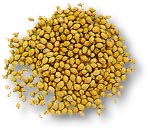|
 
|
The web site........,
exploring
the pure
Indian spices
and....
imperishable
dry vegetables
of
THAR....the great desert
.
|
| |
| |

Coriander has a
flavour which combines lemon and sage, with a sweet-note as
undertone. It is a cooling spice. The Greek and the Romans thought it
to be an aphrodisiac. By the third century B.C the Romans knew it
was an excellent seasoning for food. |

|
Coriander is native to the Mediterranean area. The Indian
states Gujarat,
Rajasthan, Andhra Pradesh, Tamil Nadu and Madhya Pradesh are the
major producers. |
Name in
International languages
|
Botanical name |
Family name |
Commercial part |
|
Coriandrum sativam L. |
Apiaceae |
Leaf and seed |
| Spanish |
Culantro |
| French |
Corriandre |
| German |
Koriander |
| Swedish |
Koriander |
| Arabic |
Kuzhbare |
| Dutch |
Koriander |
| Portuguese |
Coentro |
| Russian |
Koriandr |
| Japanese |
Koendoro |
| Chinese |
Hu-sui |
| Hindi |
Dhania |
|
Cultural
name |
English
name |
Botanical
name |
Moisture
g/100g |
Protein
g/100g |
Fat
g/100g |
Minerals |
Fiber
(g) |
Carbohydr
ate
g/100g |
Energy
Keal/1000g |
|
Dhania |
Coriander
|
Corriandum
sativum |
11.2 |
14.1 |
16.1 |
4.4 |
32.6 |
21.6 |
288 |
| |
|
|
Calcium
mg/100g |
Iron
mg/100g |
Phosphorus
mg/100g |
| |
|
|
630 |
7.1 |
393 |

In Indian cuisine, coriander is mainly
used for taste. Frying, roast-ground coriander powder in oil gives the
characteristic `curry’ flavour. Coriander seeds have diuretic properties.
It alleviates gas and tones the digestive tract.
|
|